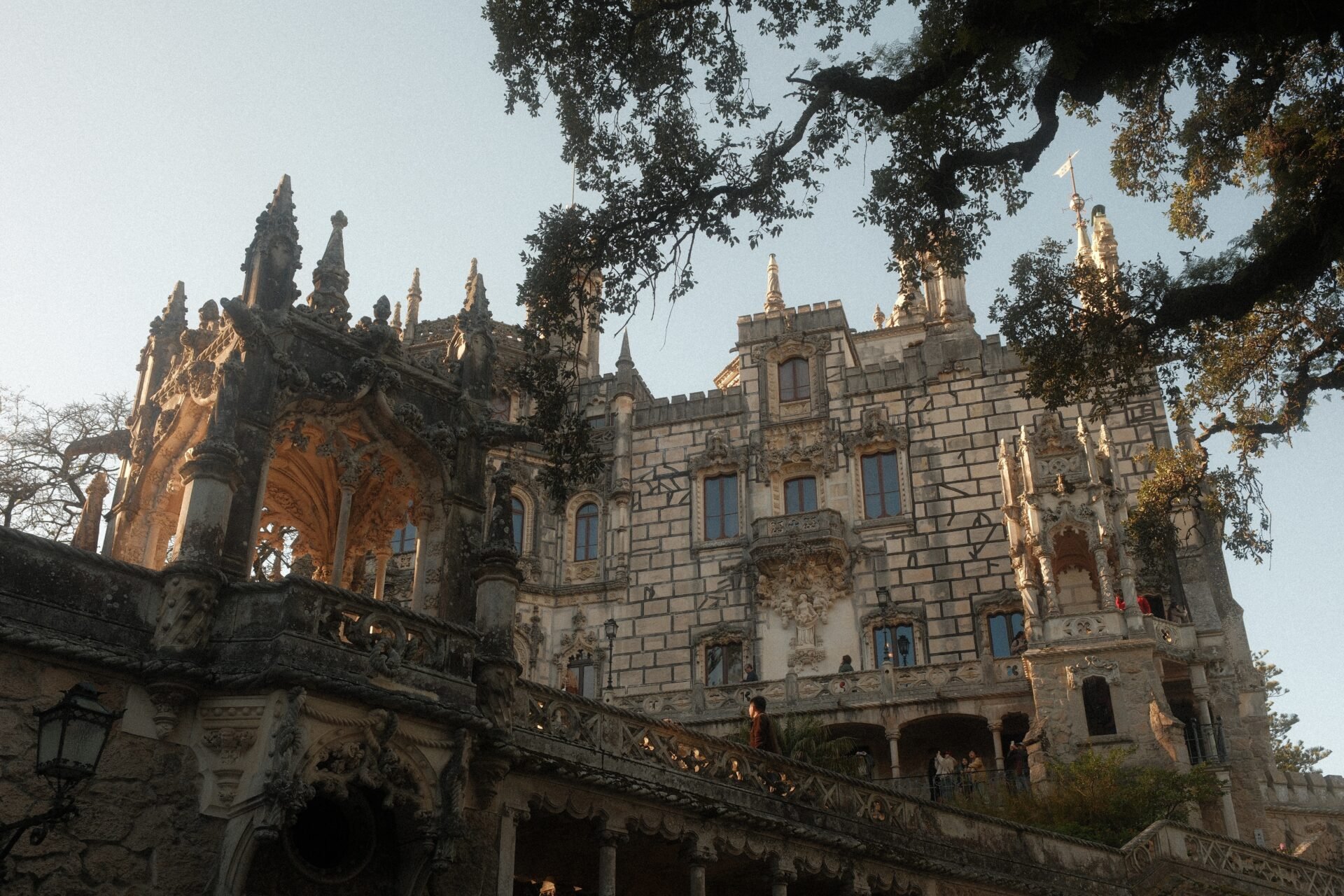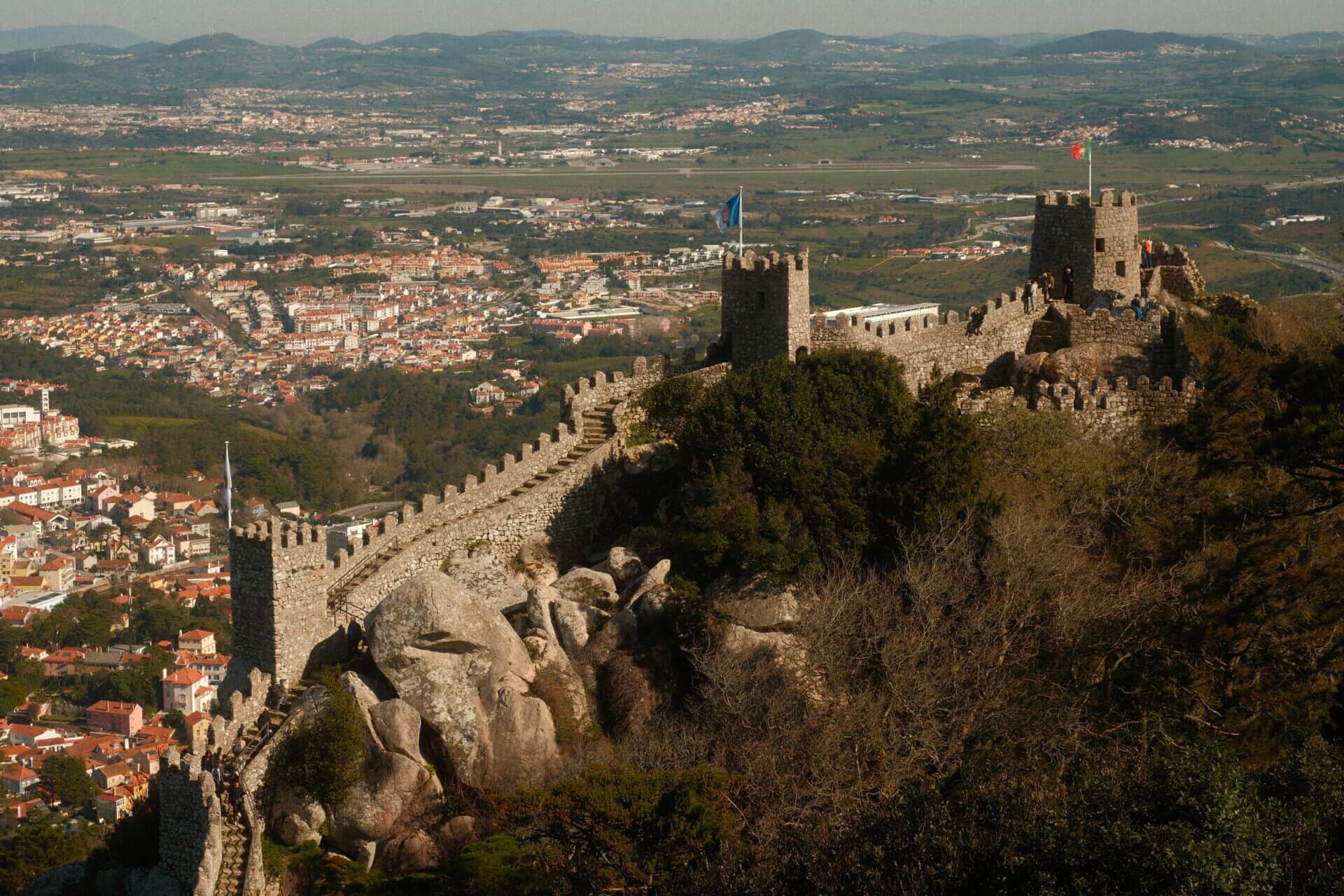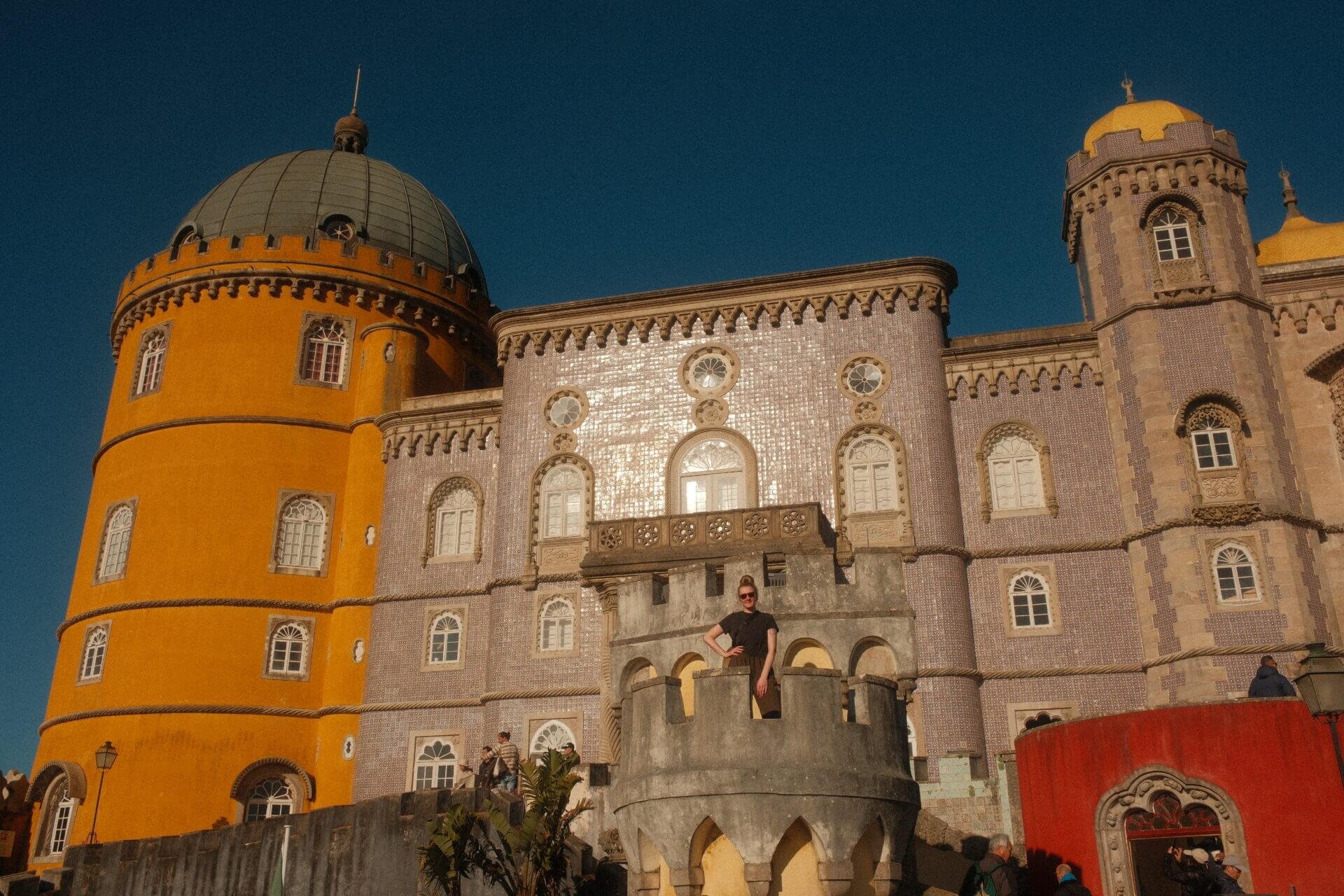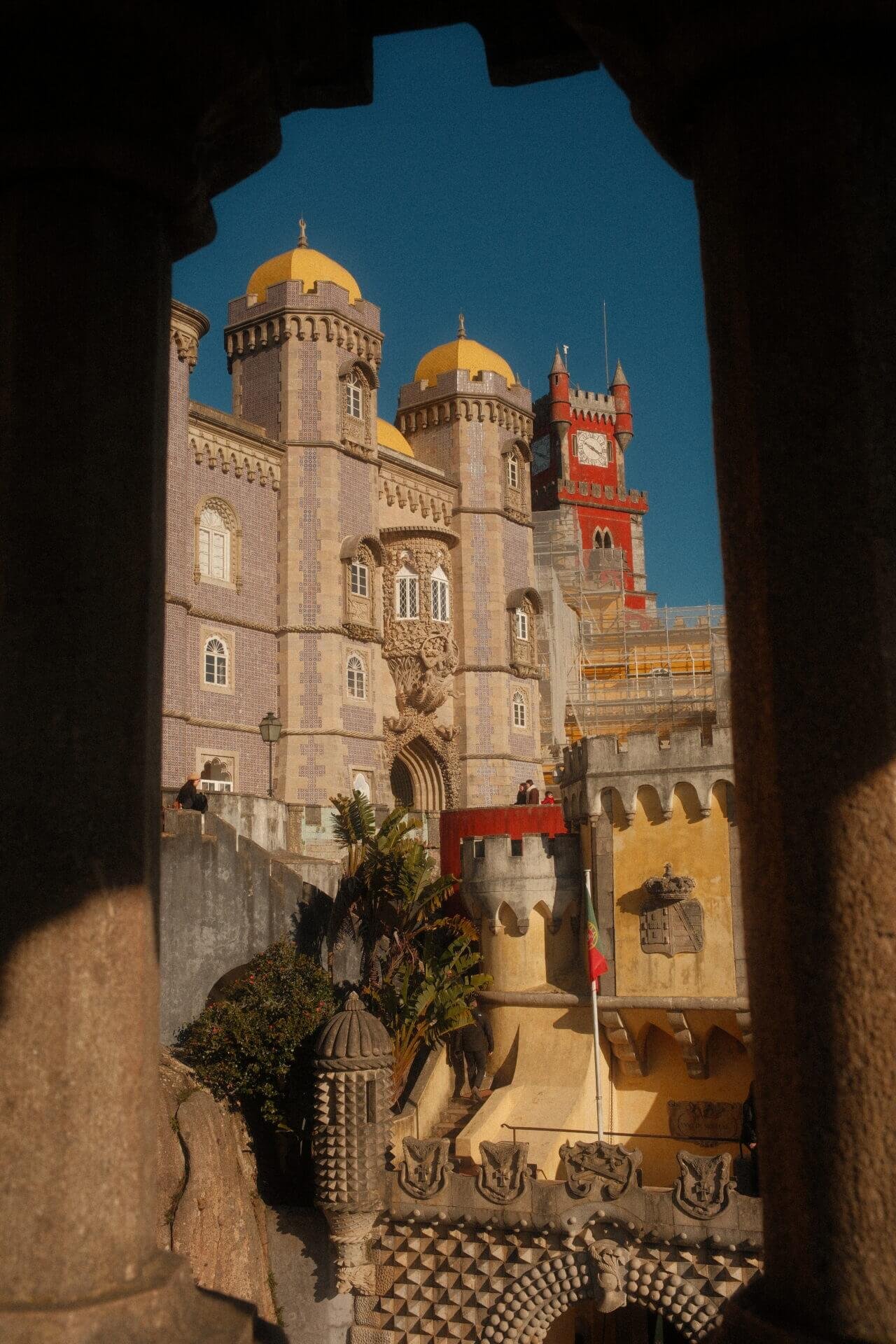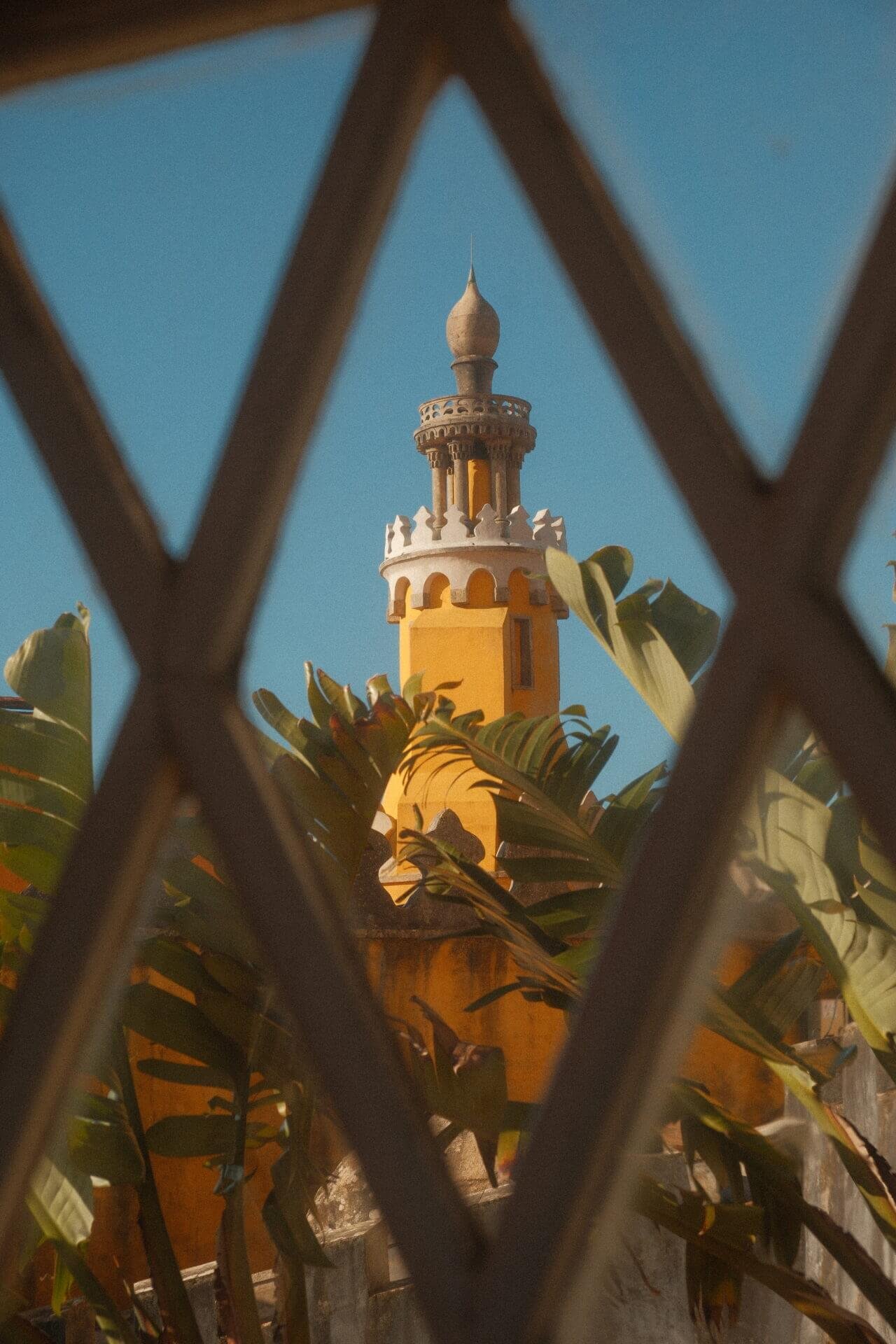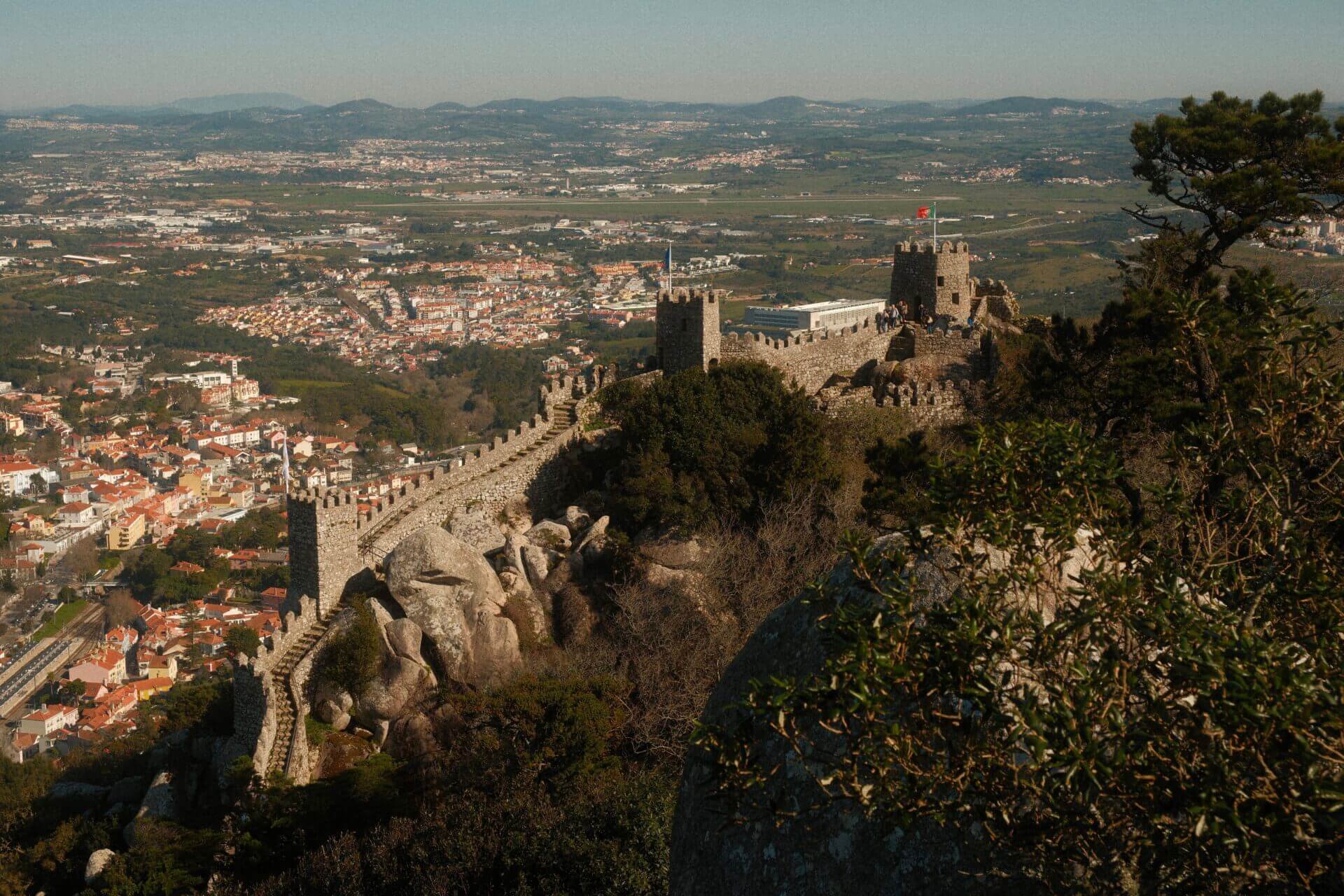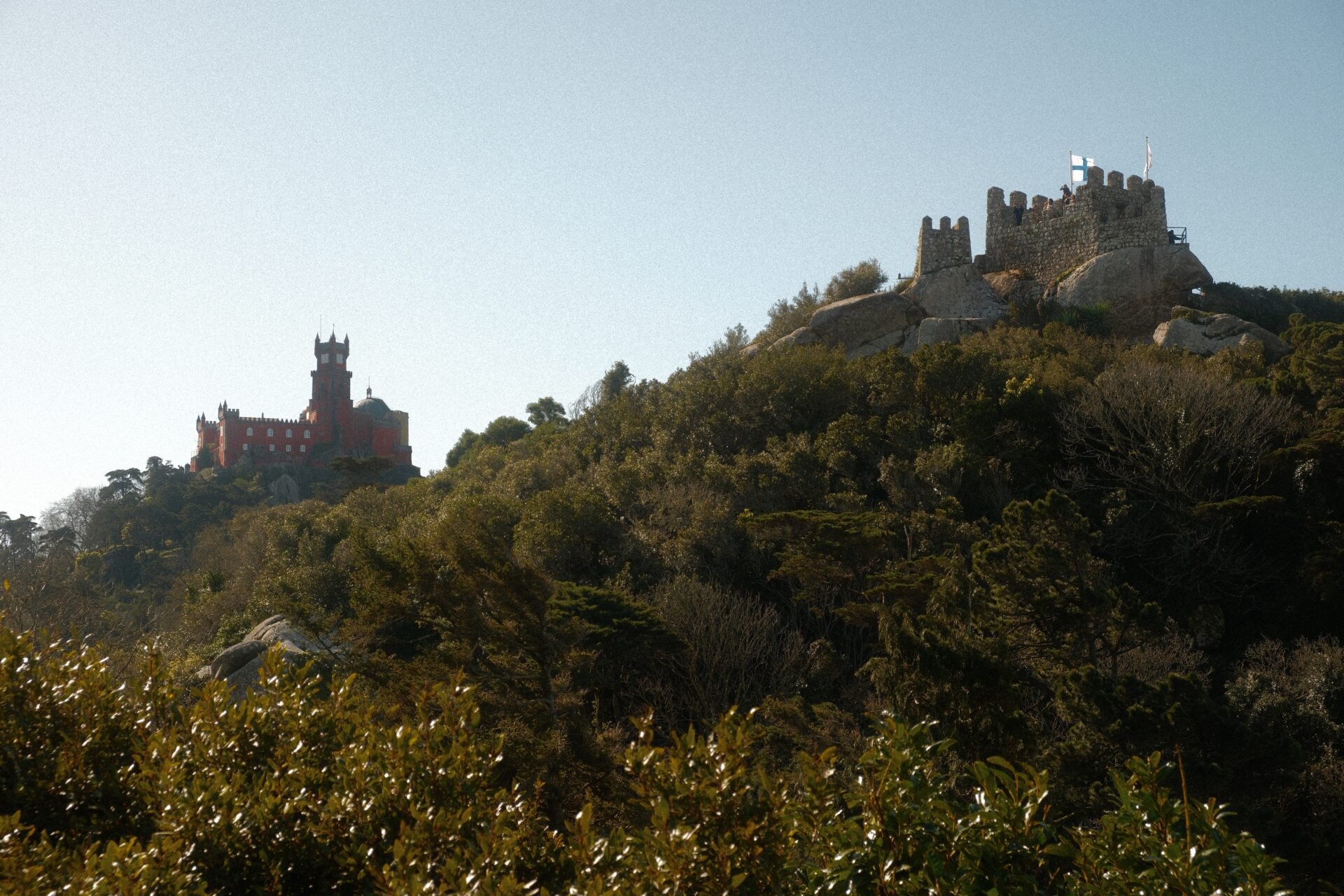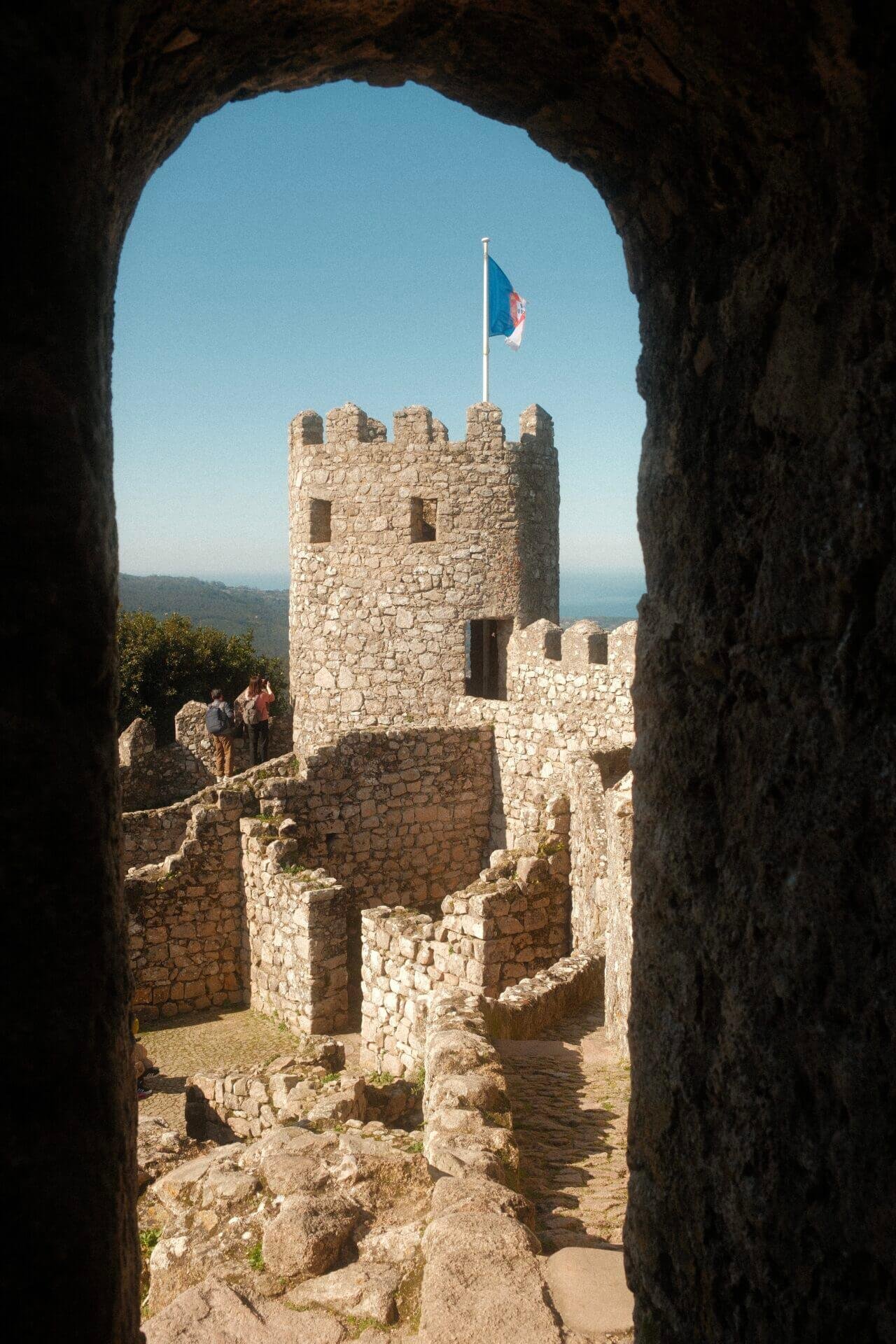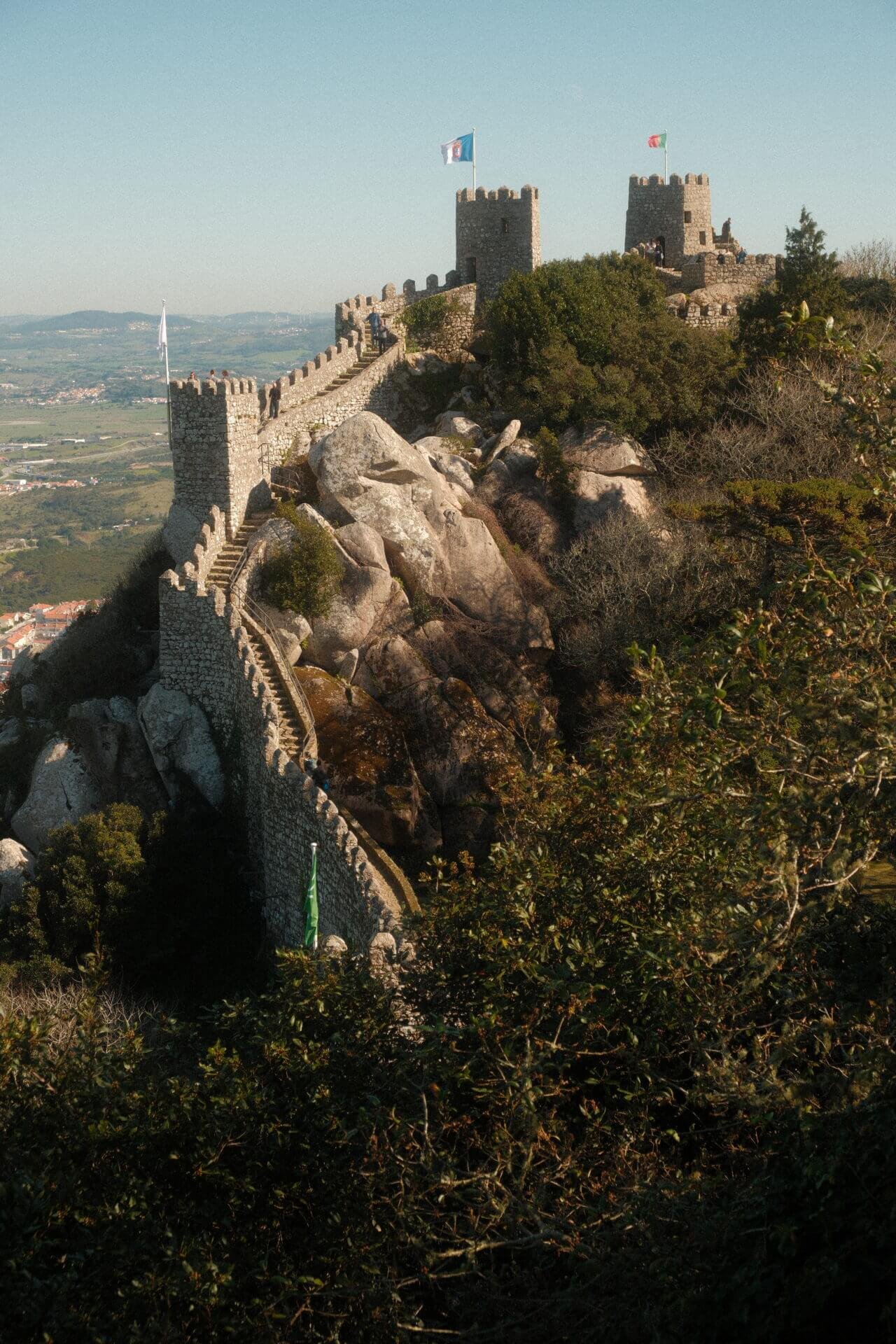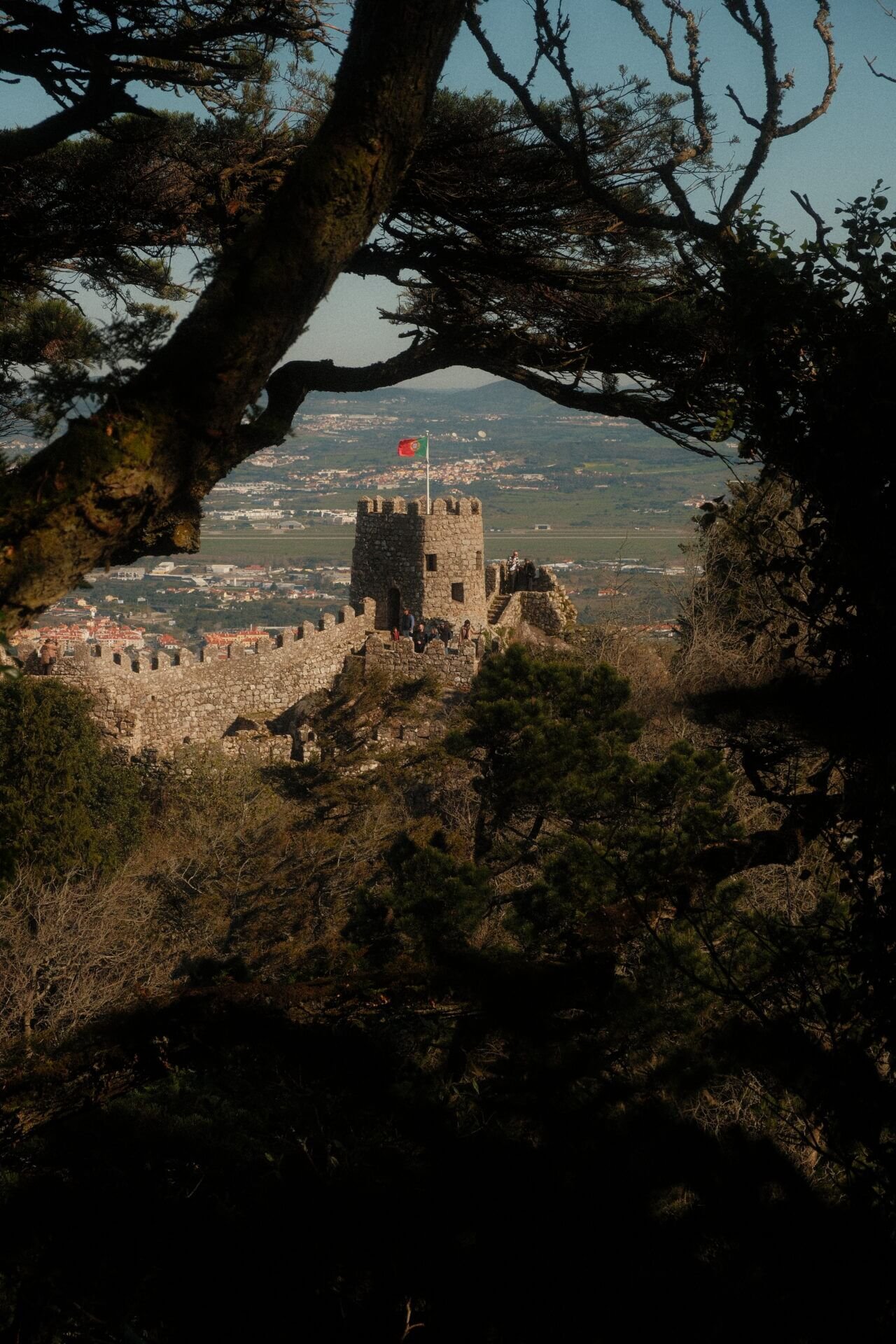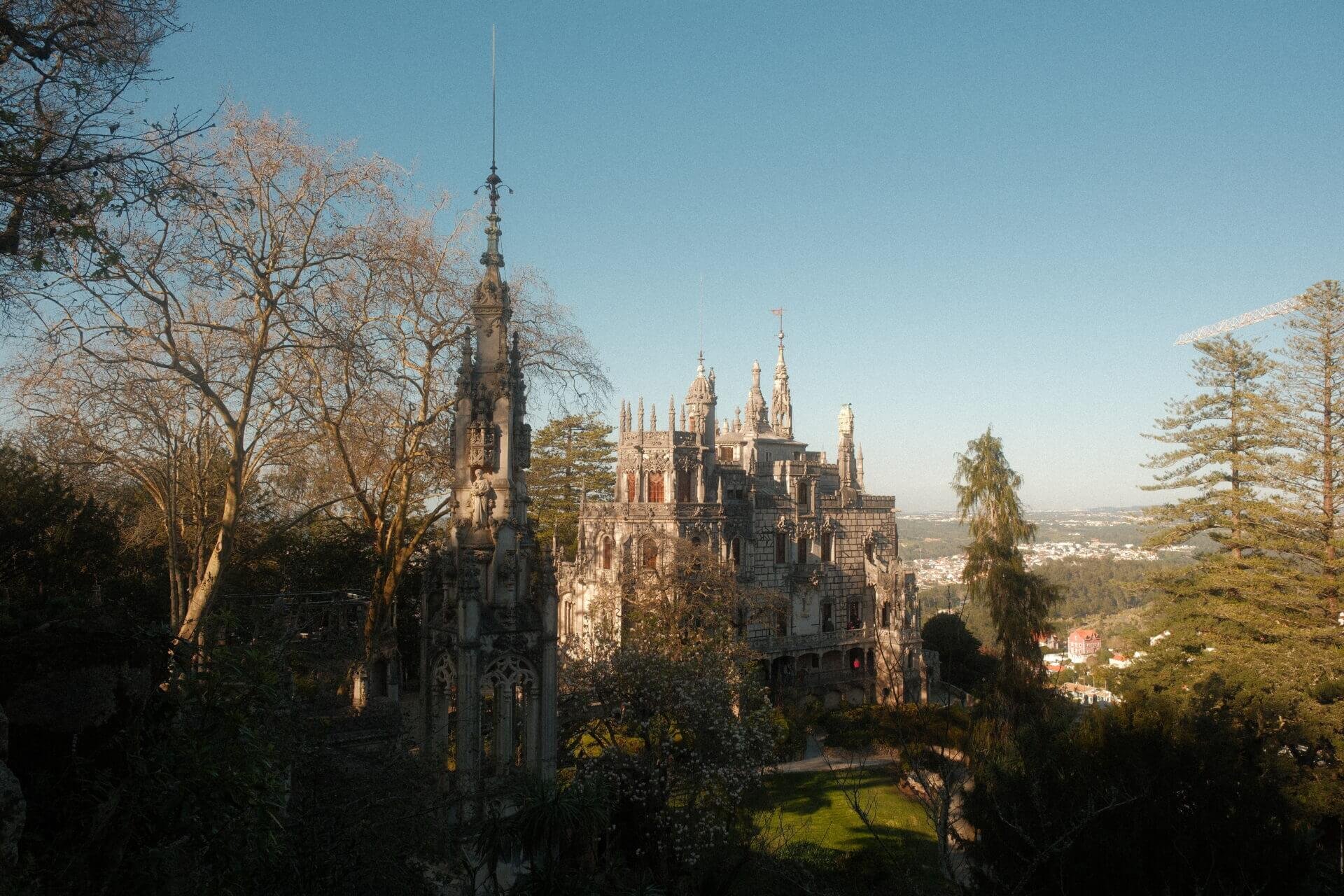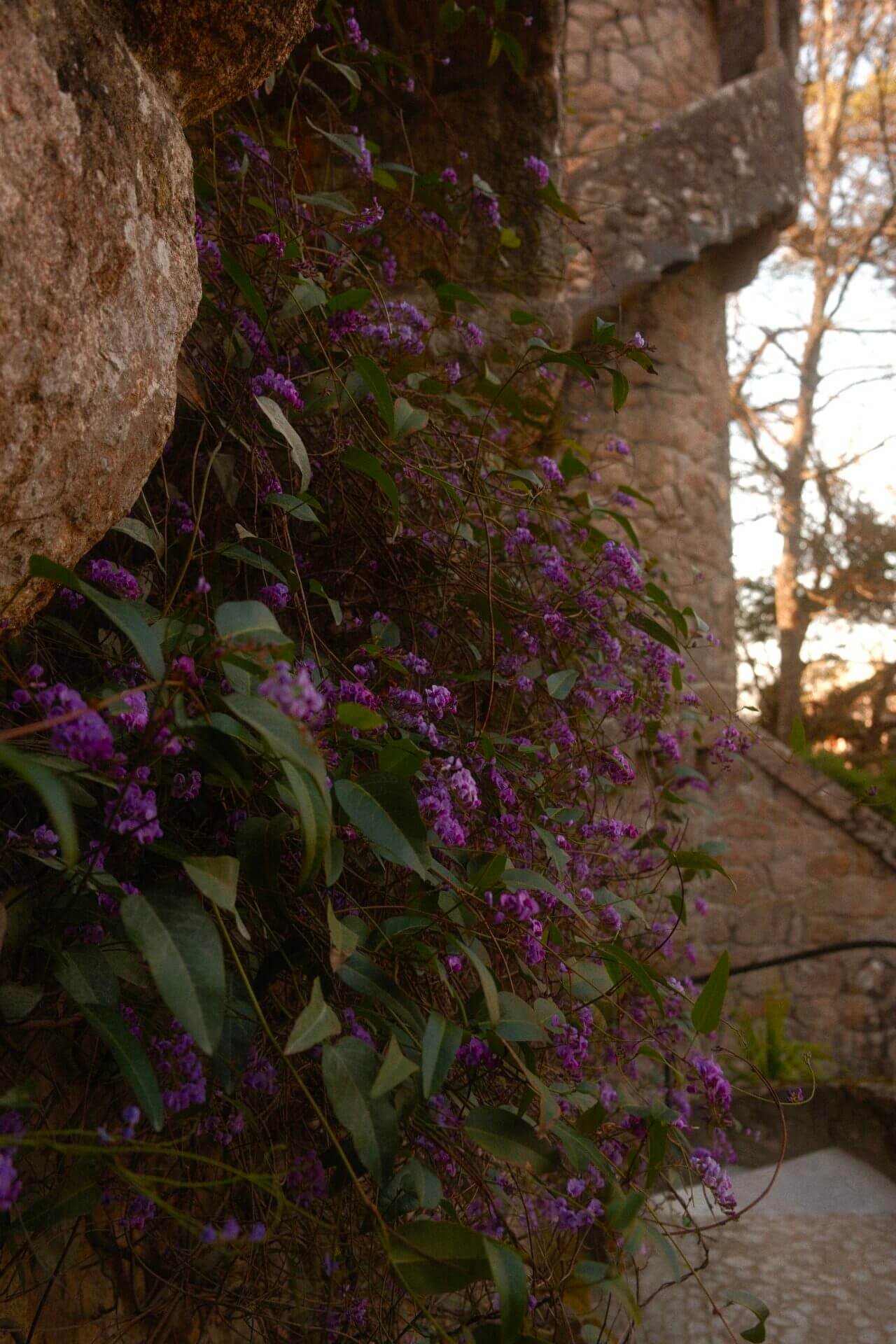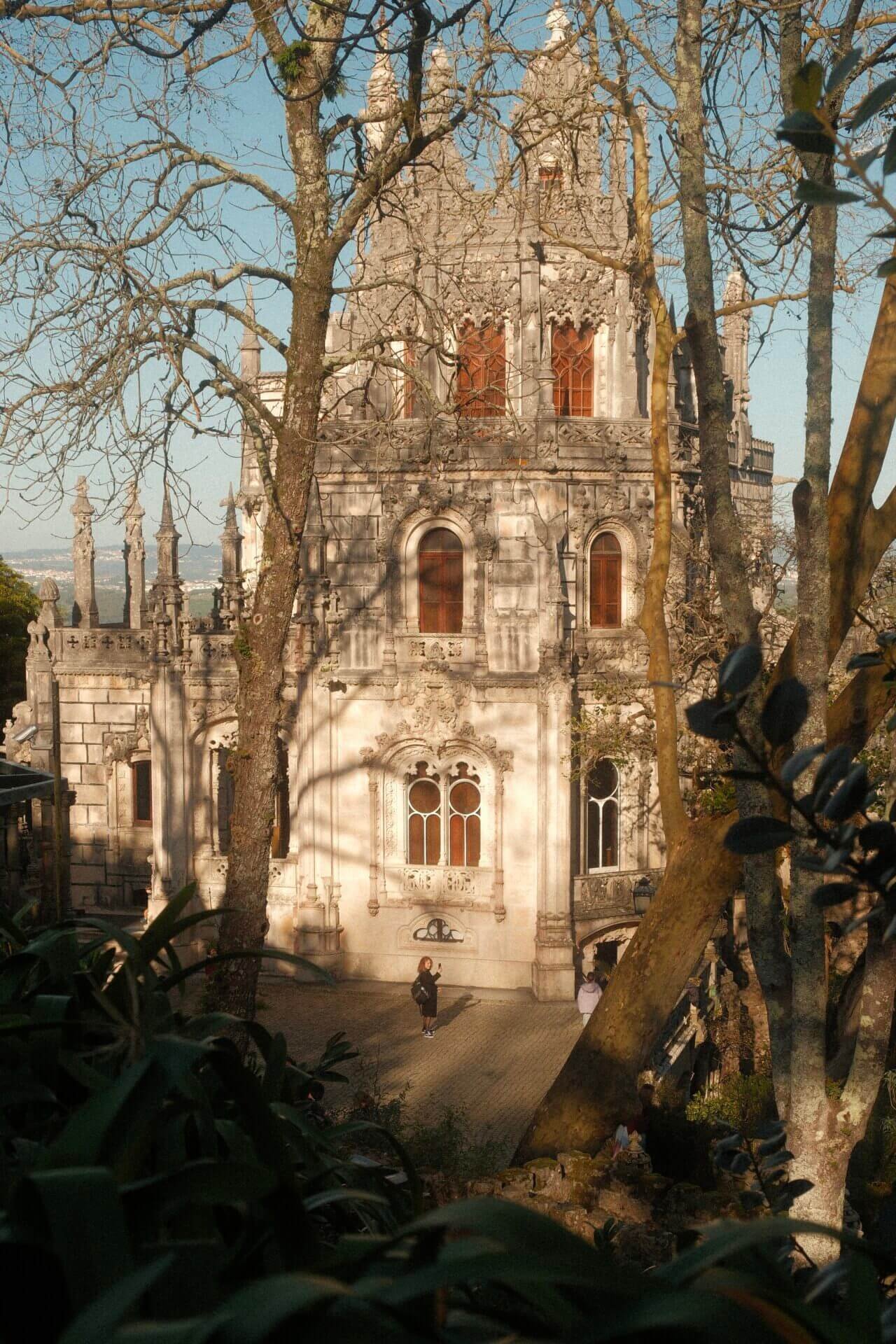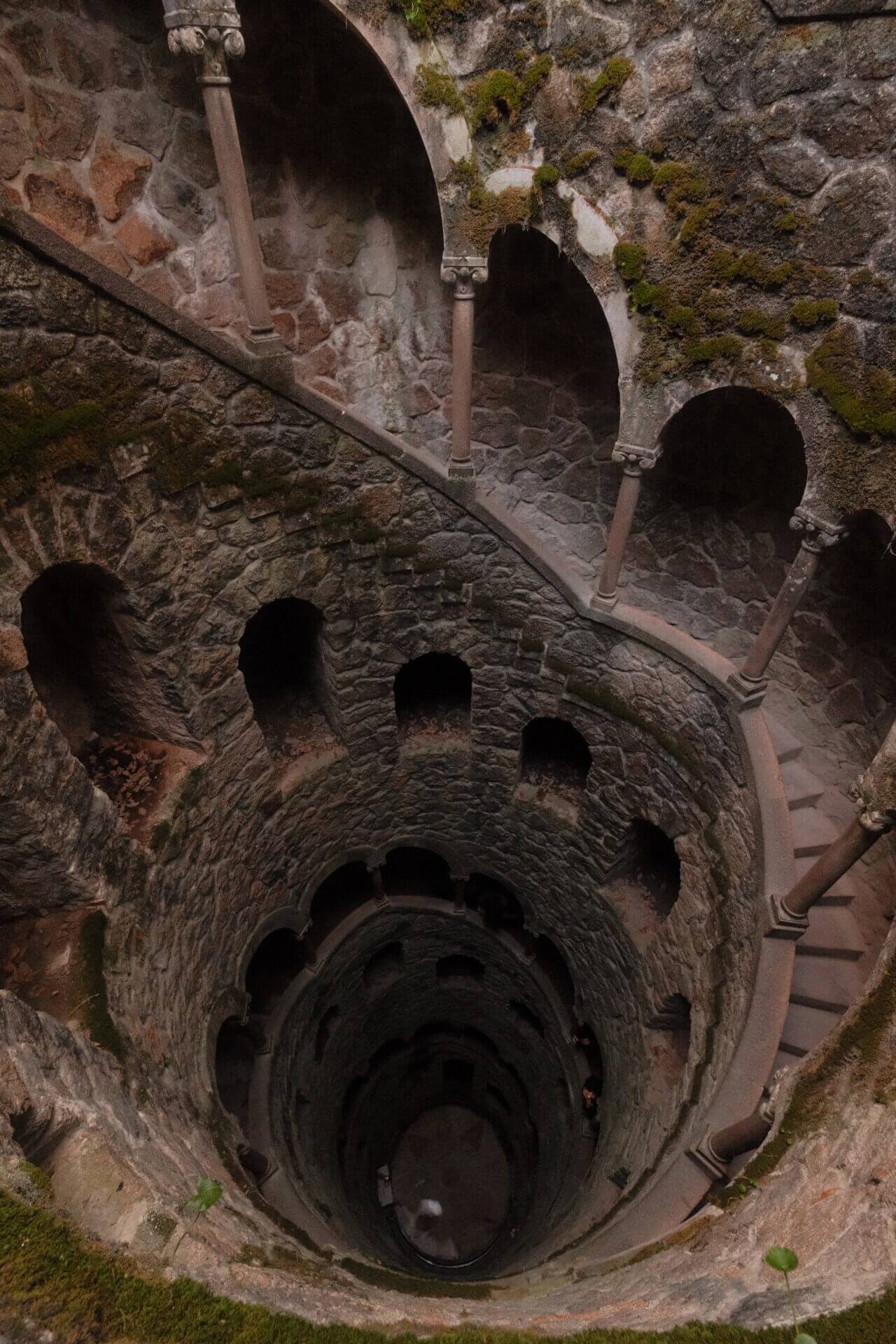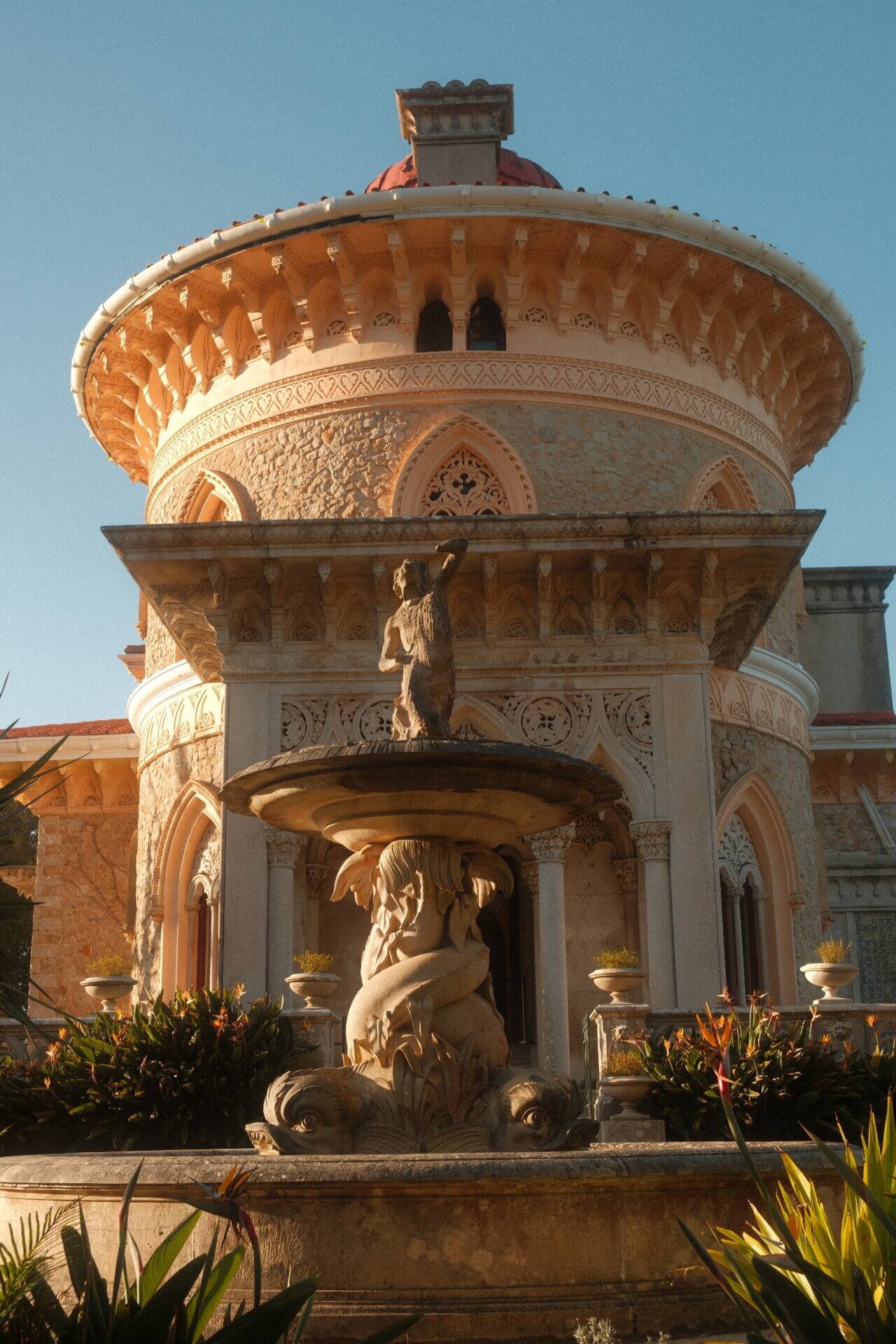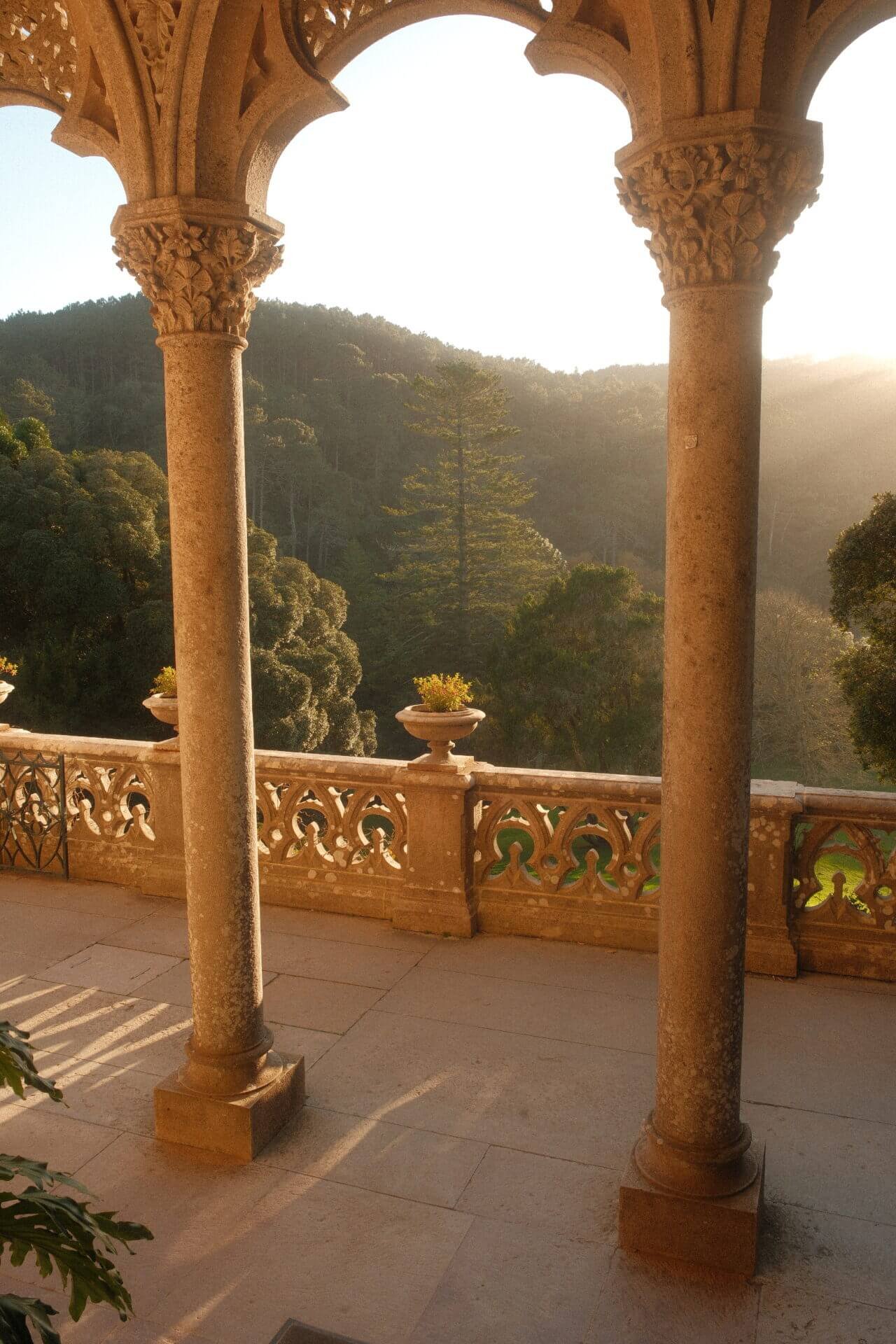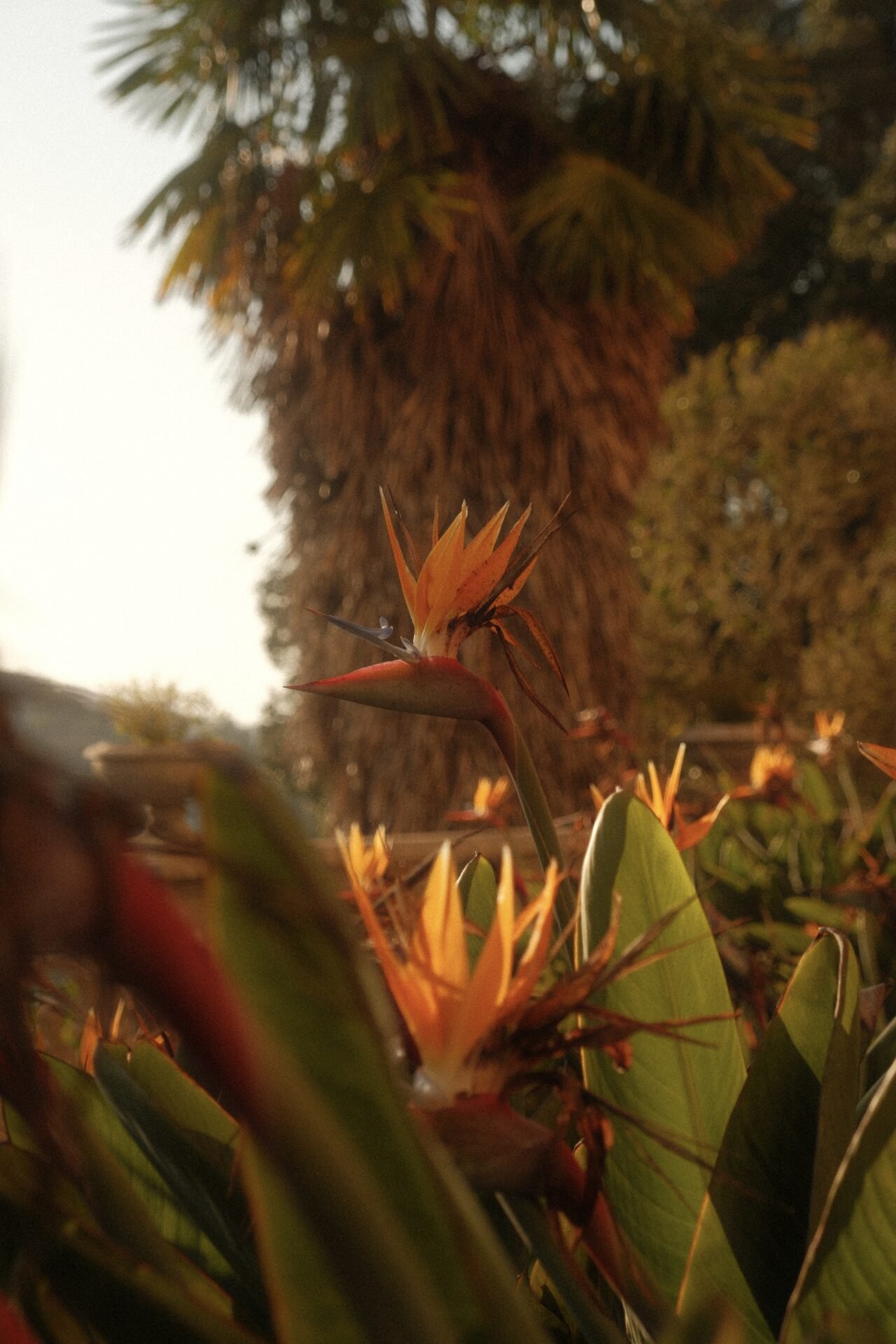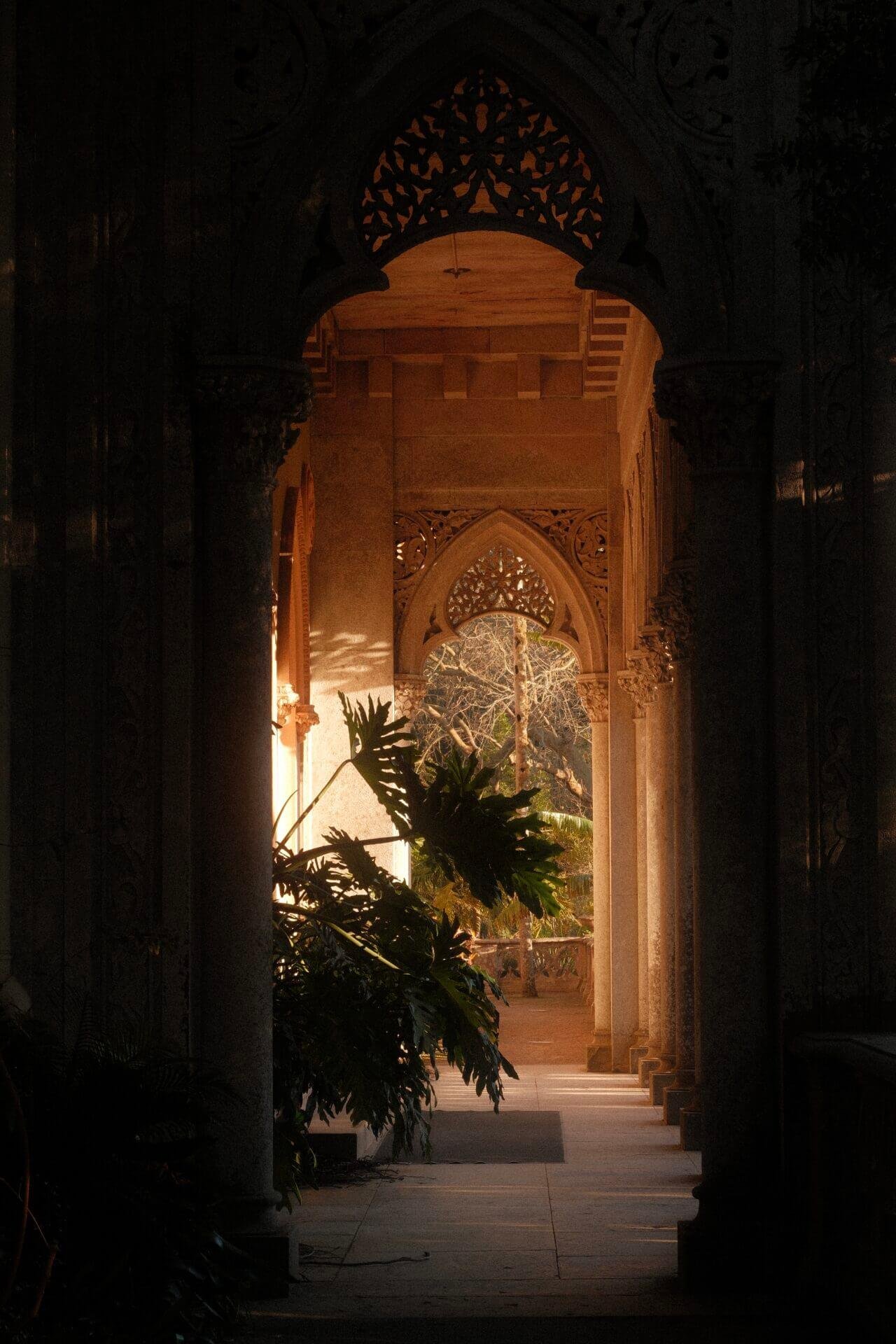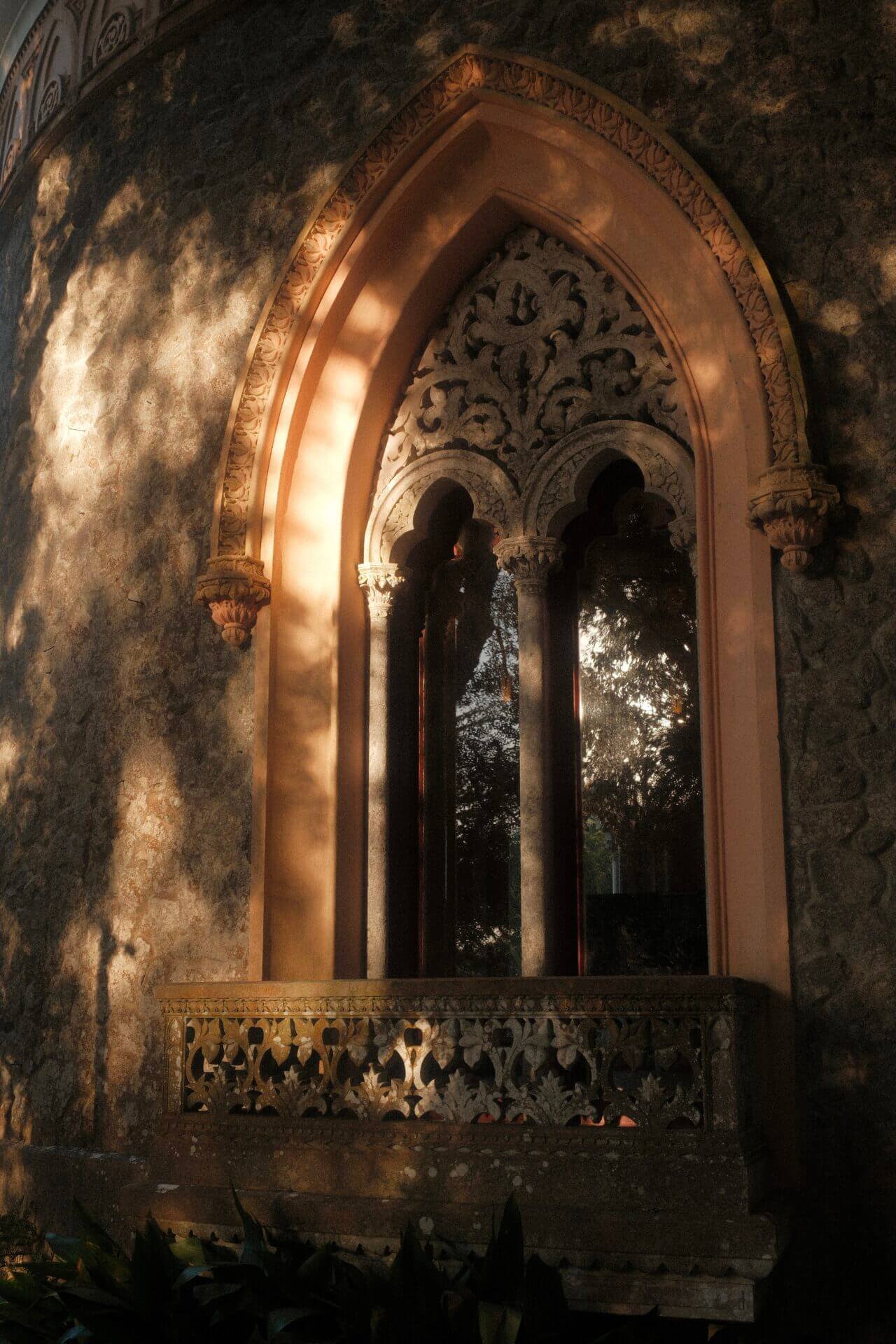How to Plan a Day Trip to Sintra from Lisbon
Visited February 5, 2025
Quinta da Regaleira – Photos in this post were taken on my Fujifilm X-T5 using the Summer Chrome recipe
Sintra is a dream destination for fantasy enthusiasts and is often hailed as the best day trip from the Lisbon region (you can read about how to have the perfect day in Lisbon here). Once a favored summer retreat for Portuguese nobility and royalty, this UNESCO World Heritage Site captivates visitors with its stunning array of majestic palaces, grand villas, and historic landmarks, all nestled among dense woodlands and dramatic hills. The town’s history is as rich and varied as its landscape. Its strategic location, offering natural defenses and close proximity to the coast, made it a desirable settlement for ancient civilizations. Over the centuries, the Celts, Romans, Visigoths, and Moors each left their mark, shaping Sintra’s unique blend of architectural styles and cultural influences.
The main reason my sister and I, or anyone, would want to visit Sintra is to explore its incredible palaces, manors, and castles. In just one day, we managed to visit all four of the main ones! Covering so many sites in a single day can be exhausting, so be sure to wear comfortable walking shoes, bring plenty of water and snacks, and check out our itinerary below to make the most of your visit.
Itinerary
Train from Lisbon to Sintra – Rossio Train Station
Train from Sintra to Lisbon
How to get to Sintra from Lisbon
The most convenient and budget-friendly way to reach Sintra from Lisbon is by train. Departing from Rossio Train Station, the journey takes about 40 minutes, with multiple stops along the way. Trains run every 20 to 30 minutes, starting at 5:41 AM. You can find the schedules for both the Rossio-Sintra and Oriente-Sintra lines here. A one-way ticket costs less than €3. If you plan to use the local buses in Sintra, I recommend purchasing the slightly more expensive combined bus and train ticket for unlimited travel throughout the day.
We took the 8:11 AM train to arrive in time for the 9:30 AM opening of the National Palace of Pena. Keep in mind that during peak tourist season, especially on weekends, the train station can get quite crowded. If you plan to explore Pena Palace’s interior at the opening tour slot or are visiting during peak season, arriving earlyto the train station to secure a spot to Sintra is highly recommended.
Getting Around Sintra
Once you arrive, you can get around Sintra easily via bus, tuk-tuk or Uber. I don’t recommend walking everywhere because you will be doing plenty of walking at each site. My sister and I utilized a combination of Uber, tuk-tuk, and some walking. Uber can get very busy, especially in the early afternoon. Whenever we couldn’t catch an Uber, we would hop on one of the many tuk-tuks hanging out in front of each site.
If you’re looking for a budget-friendly way to get around, taking the bus is your best option. There are two main routes: Bus 434 and Bus 435. Bus 434 departs from the train station and stops at the city center, the Moorish Castle, and Pena Palace. Bus 435 also starts at the train station and takes you through the city center, then on to Quinta da Regaleira, Seteais Palace, and Monserrate Palace. During peak season, buses can have long lines, so be sure to arrive early and plan accordingly.
It’s best to head straight to Pena Palace first, as it’s the most popular palace and gets increasingly crowded throughout the day. Since Pena Palace sits atop a hill above the other sites, starting there allows you to work your way down, making your visit more efficient and enjoyable.
National Palace of Pena
My sister striking a pose in front of the palace
Perched atop the second-highest point of the Sintra Mountains, Pena Palace is a breathtaking example of Romantic-era architecture. Its history dates back to the 12th century, when a chapel once stood on the very site where the palace now stands.
As I mentioned earlier, if you plan to tour the interior of Pena Palace, it’s best to arrive early. To secure your spot, you can purchase tickets online in advance here. The earliest available time slot is 9:30 AM, with additional slots available every 30 minutes throughout the day. My sister and I weren’t particularly interested in taking the tour. I had read reviews suggesting that the interior was underwhelming and that the tour was rushed, with visitors being shuffled through in a single-file line. However, we still wanted to arrive at opening to make the most of our day. So, after getting to Sintra around 9 AM, we took an Uber to the palace and purchased €10 tickets to access the palace’s exterior. There are several nooks and crannies to discover, so take your time exploring each one.
The Moorish Castle
The Moorish Castle, built in the 10th century during Moorish rule over the Iberian Peninsula, stands as a formidable stronghold. Its iconic walls wind through rugged hills, where sturdy granite blocks blend seamlessly with natural boulders and steep cliffs. Perched in a strategic position, the fortress was vital for defending both the surrounding lands and the crucial maritime routes leading to Lisbon.
To reach the castle, you can take a short ride by tuk-tuk or Uber or enjoy a 20-minute downhill walk from Pena Palace. My sister and I chose to walk, appreciating the peaceful and scenic route.
Keep in mind that exploring the Moorish Castle requires a fair amount of effort. Expect to spend over an hour walking on hills, climbing stairs, and navigating narrow battlements. If you’re traveling with young children or have mobility limitations, I recommend skipping this site. Tickets for the Moorish Castle cost around €12. You can buy them either at the castle entrance or about 200 meters down the trail, just inside the gate at the base of the castle.
Once inside the Moorish Castle, you’re immediately met with an uphill climb. We chose to explore by taking the stairs on the right and trekking along the walls in a counterclockwise direction. Of all the sites we visited, this one undeniably offered the best views. The higher we climbed, the more breathtaking the scenery became, not just of the castle itself but also of the vast landscape and coastline stretching beyond. While Pena Palace sits at a higher elevation, the Moorish Castle boasts more unique and expansive panoramas. Though exploring it takes some effort, every step is truly worth it.
Lunch in the Historic Center
After exploring two sites (especially with all the walking at the Moorish Castle) we had worked up quite an appetite. It was time to head to Sintra’s Historic Center for lunch. While you can walk downhill to the center, it takes about 50 minutes. Instead, we opted for an affordable €5 tuk-tuk ride, as Ubers were becoming busy and unavailable at that time.
If you choose to skip the Moorish Castle or have extra time, exploring the Historic Center might be of interest. In addition to charming, winding alleys, you’ll find museums and smaller manors and palaces scattered throughout the area. Since we still had two more stops on our agenda, we grabbed a quick bite at Tascantigabefore walking over to Quinta da Regaleira.
Quinta da Regaleira
Quinta da Regaleira is a dream destination for fantasy lovers. This 16th-century estate boasts a stunning Renaissance-style manor, built by Freemason Carvalho Monteiro, an etymologist with a deep passion for lyrical poetry. Spanning 40 acres, the property is steeped in mystery, featuring the enigmatic Initiation Well and adorned with Pagan and occult symbols. As you wander the grounds, you’ll be immersed in Gothic architecture, dense woodlands, and an air of intrigue, leaving you to wonder what inspired the creation of such a fascinating place.
Before you even step through the gates of Quinta da Regaleira, you’ll see majestic towers rising above the landscape. Tickets cost around €15 and can be purchased online in advance or upon arrival. When my sister and I visited, we encountered a long line. I was able to buy tickets online for the most current time slot, allowing us to skip the wait. Once inside, a vast and enchanting estate awaited exploration.
With the property being approximately 40 acres, Quinta da Regaleira is another site where you’ll be doing plenty of walking. While you could easily spend over four hours uncovering every hidden corner, we managed to explore most of the main areas in about two hours. A large path winds uphill from the palace, with smaller trails branching off in every direction. Wandering these paths feels like stepping into a magical world, surrounded by towering structures and moss-covered cobblestones. Our main priority was to find the famous Initiation Well, the entrance of which can be found by winding up the main path towards the top of the property.
The Initiation Well is one of Sintra’s most iconic landmarks, drawing fascination with its mysterious design and unclear purpose. I mean, as amazing as it is, who would build a well like this? From the bottom, the view of the circular patch of sky above makes it appear as though a tower is buried in the earth. In reality, the structure is more symbolic than functional. The well was created for spiritual purposes and is said to represent the nine circles of Dante’s Inferno. Though it’s only six stories deep, the experience of descending into the well gives the illusion of endless depth, highlighting its evocative and imaginative design.
If you’re planning to spend more time in Sintra, I highly recommend setting aside half a day for Quinta da Regaleira to fully explore this enchanting property. However, if you’re like us and are short on time, two hours should be enough to see the main attractions, including the Initiation Well. No matter how much time you have, you’ll be able to experience the magic of feeling like you’re stepping into in a fantasy world.
Monserrate Palace
In 1863, after centuries of changing owners, restorations, and periods of neglect dating back to 1540, British trader and art collector Francis Cook purchased the Monserrate Estate and was named the 1st Viscount of Monserrate. He commissioned the construction of a palace that blends Gothic, Indian, and Moorish styles. Its intricate interior, decorated with exotic plant-inspired designs, flows seamlessly into the surrounding gardens, which were transformed into one of Portugal’s most stunning botanical landscapes. Taking advantage of the mountain’s unique climate, the gardens were carefully designed to support a diverse range of plant life and remain home to over 3,000 exotic species today.
A short tuk-tuk ride took us from Quinta da Regaleira to Monserrate Palace, our final stop of the day. We arrived just in time for golden hour, where warm light bathed the entire palace in a soft glow. After purchasing our €8 tickets, we entered the palace gates. To reach Monserrate, you can either walk 800 meters through the gardens along the leftmost path or take a shorter route to the right that winds through the forest and past a waterfall. Even though we visited in February, when the gardens weren’t at their peak, their beauty was still undeniable.
As we were leaving for the train station, we spotted a cat curled up in a plant. It was barely moving, even after petting it, and I started to worry that something might be wrong. Hoping to catch its interest, I tore up a meat snack I had bought from Pena Palace earlier in the day. Sure enough, the cat sniffed the food before eagerly gobbling it down.
If you’re planning a day trip from Lisbon, Sintra should definitely be on your list. In addition to the four sights we visited, there are countless hidden gems to discover throughout the town. I hope this guide helps you plan your own magical day in Sintra.
